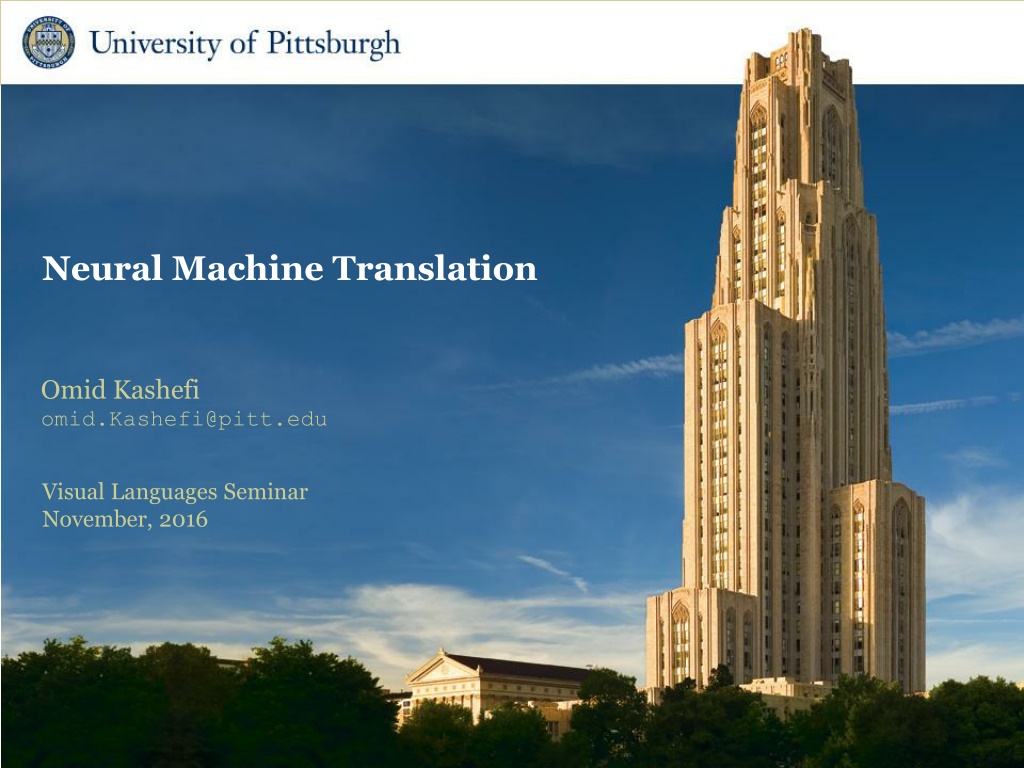
Neural Machine Translation Overview
Explore the evolution of machine translation, from rule-based approaches to deep learning models like neural machine translation. Dive into the concepts of RNN encoder-decoder architecture and the mathematics behind statistical machine translation. Discover the power of deep learning in transforming language processing.
Download Presentation

Please find below an Image/Link to download the presentation.
The content on the website is provided AS IS for your information and personal use only. It may not be sold, licensed, or shared on other websites without obtaining consent from the author. If you encounter any issues during the download, it is possible that the publisher has removed the file from their server.
You are allowed to download the files provided on this website for personal or commercial use, subject to the condition that they are used lawfully. All files are the property of their respective owners.
The content on the website is provided AS IS for your information and personal use only. It may not be sold, licensed, or shared on other websites without obtaining consent from the author.
E N D
Presentation Transcript
Cross-Lingual Morphology Disambiguation Omid Kashefi Neural Machine Translation Omid Kashefi omid.Kashefi@pitt.edu Visual Languages Seminar November, 2016
Outline Machine Translation Deep Learning Neural Machine Translation
Machine Translation Machine Translation Use of software in translating from one language into another Oldest Natural Language Processing Problem Late 40 s (Weaver 1949) Cryptoanalysis Rule-based Approaches
Machine Translation Statistical Machine Translation Parallel corpus The mathematics of statistical machine translation (Brown et al. 1993) Introduced five models Word alignments Phrase-based Machine Translation (Koehn et al., 2003) Phrase alignment
Deep Learning Good Old Neural Networks Computation Power Data Deep Learning
Deep Learning Deep Learning Simplicity Hand-crafting features Feature engineering Representation Learning Does it works (remarkably) better? Not necessarily When to use it? Having a lot of data
Neural Machine Translation Translation Problem Find target sentence y Maximize the conditional probability of y given source sentence x arg max p(y|x) Encoder-Decoder (Sutskever et al., 2014) Encode the source sentence x Decode that to target sentence y
Neural Machine Translation RNN Encoder Read input sentence x = (x1, x2, , xn)into a vector c ht = f(xt,ht 1) c = q({h1, h2, ,hn })
Neural Machine Translation RNN Decoder Predict the next word yt Given the context vector c And all previously predicted words(y1, y2, , yt 1) p(y|x) ? p(y) = ?=? ? ?? ??, ,?? ?,?) RNN ? ?? ??, ,?? ?,?) = ?(?? ?,??,?)
Neural Machine Translation Compared to even easiest model, IBM Model 1 (Brown et al. 1993) Extensive domain knowledge 20 slides of complex formula Compared to state-of-the-art (Koehn et al., 2003) Performs comparably good
Neural Machine Translation Improvements Jointly train decoder and encoder (Cho et al., 2015) Variable length context vector (Bahdanau et al., 2015) Hybrid Models Phrase-based translation Score phrase pairs with RNN (Cho et al., 2014) Reorder translation candidates (Sutskever et al., 2014)
